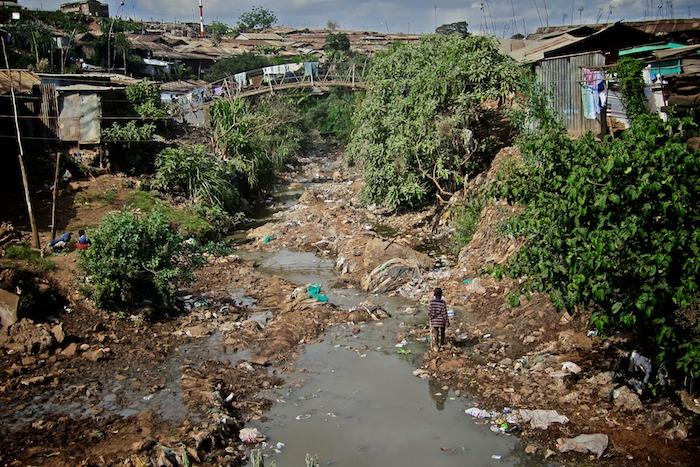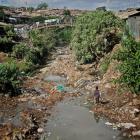Scarce and poorly managed urban water resources and infrastructural exclusion in Nairobi have created a parallel water economy that undermines the legitimacy and sustainability of the government-regulated water supply system. This struggle over Nairobi’s water raises questions of who are legitimate receivers and providers of water.
In January 2023, while Kenya was still struggling with a three-year drought, the national government of Kenya set up the Water Police Unit to protect vital water infrastructures. By spring, “crackdowns” were happening all over Kenya, with illegal water connections being disconnected and removed. Nairobi and its slums were particularly targeted. In the largest slum area, Kibera, water vendors were working around the clock in the days following these crackdowns, frantically trying to re-establish their water supply; their unauthorized connection had been cut off from the formal supply lines around the settlement. Near the main supply line on the outskirts of Ngong forest, from where a significant amount of the diverted water had come, colourful plastic pipes were stiffly poking out of the ground like wheat stubble, their way to the water kiosks and standpipes in Kibera cut at the stem.

A polluted waterway in Kibera.
A polluted waterway in Kibera.
Photograph by Colin Crowley, 2009. Click here to view source.
 This work is licensed under a Creative Commons Attribution 2.0 Generic License.
This work is licensed under a Creative Commons Attribution 2.0 Generic License.
Crackdowns that cut off illegal water connections have been routine in Kibera for years; however, until 2023, they had mostly been carried out by the field team of the state-owned water service provider, Nairobi Water. The 2023 crackdowns seemed more extensive than any of the previous ones and were overseen by staff from Nairobi Water’s headquarters and armed police from the new special unit. It did not take long, however, for the Kibera vendors to reconnect with their unregulated lines to the grid and regain temporary control over the water flows.

Jerry cans in line to be filled for a water kiosk, Kibera 2024.
Jerry cans in line to be filled for a water kiosk, Kibera 2024.
Photograph by Maja Jeppesen, 2024
 This work is licensed under a Creative Commons Attribution 4.0 International License.
This work is licensed under a Creative Commons Attribution 4.0 International License.
The Water Police Unit was established following years of large quantities of unbilled and unaccounted for water in Kenya, in Nairobi as much as fifty percent. This is partly due to leakage; Nairobi Water inherited a deteriorating infrastructural system when it took over water provision from the Nairobi City Council in 2003, with many pipes dating back to the colonial era. Another reason is the diversion of water to the slum, and it was this that the Water Police Unit tried to combat in spring 2023. The diversion of water to Kibera means that the middle-class users downstream receive less water, undermining Nairobi Water’s already strained ability to meet their demands. The water provider’s mandate is further challenged by their inability to serve those living in slums, which, at fifty percent of the city’s population, also represent a huge untapped base of potential customers. As the state’s lack of control over of the city’s water resources undermines its legitimacy to provide it—reflected in a growing dissatisfaction among the city’s inhabitants—it becomes essential to bring the slums within its service reach. An employee from Nairobi Water expressed this urgency: “Our main objective is serving, even if they don’t want us to, we will serve them by force.”
Nairobi is shaped by a colonial history of infrastructural inequality, where the infrastructural layout of the city has defined who is recognized as a state subject worthy of services and who is not, originally based on ethnicity and later along socio-economic lines. Slums like Kibera are still defined by their lack of infrastructural integration and formal rights to the land on which they live, despite many of them being almost as old as Nairobi itself. However, infrastructures can also become a political terrain where existing authorities are challenged and new political subjectivities arise. In the face of neglect and exclusion, the slum dwellers have found ways to provide for themselves, diverting water from the grid and selling it to other residents.
The interventions of the Water Police Unit have been coupled with efforts to integrate Kibera into the formal provision system. One effort is the so-called “chambers,” where Nairobi Water aims to provide former illegal vendors with water through metered pipes which the vendors can then distribute and sell in the slum. In this way, Nairobi Water can expand its services there while keeping the building of new infrastructure to a minimum. However, this water is unreliable, has low pressure, and only comes a few times a week; it is insufficient to support a water vending business. More importantly, the water habits of slum-dwellers, where people buy small amounts on a day-to-day basis, do not allow for several days of rationing.

A “chamber”: a locked concrete box with legal metered connections to the grid, Kibera 2021.
A “chamber”: a locked concrete box with legal metered connections to the grid, Kibera 2021.
Photograph by Maja Jeppesen, 2021.
 This work is licensed under a Creative Commons Attribution 4.0 International License.
This work is licensed under a Creative Commons Attribution 4.0 International License.

“Spaghetti pipes” connecting water kiosks and connection points to the grid, Kibera 2022.
“Spaghetti pipes” connecting water kiosks and connection points to the grid, Kibera 2022.
Photograph by Maja Jeppesen, 2022.
 This work is licensed under a Creative Commons Attribution 4.0 International License.
This work is licensed under a Creative Commons Attribution 4.0 International License.
For this reason, Kibera residents resist state regulation of their water supply, which cannot currently offer them better than what they can organize for themselves. The vendors keep reconnecting their water pipes to the grid, avoiding the rationing of the supply lines and diverting water to the people in the slums before it makes its way to the middle-class areas downstream.
This infrastructural tug-of-war continues as the control of the city’s water is being pulled back and forth by Nairobi Water and the Kibera vendors. Pipes are constantly connected and disconnected, and water is diverted and blocked. It is a struggle not only over water but also over who has the right to control it—and who has the right to live in the city. This struggle—which only intensifies as the resource grows scarcer during droughts, like the one Kenya saw in 2020–23—both reproduces and challenges colonial histories of exclusion and the constitution of (state) power.
How to cite
Jeppesen, Maja. “Struggles over Water Rights and Legitimacy in Nairobi.” Environment & Society Portal, Arcadia (Spring 2025), no. 6. Rachel Carson Center for Environment and Society. doi:10.5282/rcc/9952.
ISSN 2199-3408
Environment & Society Portal, Arcadia
 This work is licensed under a Creative Commons Attribution 4.0 International License.
This work is licensed under a Creative Commons Attribution 4.0 International License.
2025 Maja Jeppesen
This refers only to the text and does not include any image rights.
Please click on an image to view its individual rights status.








